|
anvilfire!
Power hammer Page!
Catalog of User Built Hammers |
||
|
CR-JYH Page 2 |
||
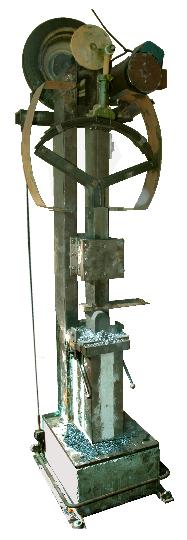

|
||
 COSTA RICA has a very small but growing blacksmithing community.
In the recent past almost all the Costa Rican ironwork other than antique examples was fabricated and primitive re-bar work.
There is a huge amount of this work in Costa Rica in the form of fences, security gates and window guards.
With the influx of expensive realestate developments high end forged work is in demand.
And with that demand has come the need for better tools, particularly power hammers.
COSTA RICA has a very small but growing blacksmithing community.
In the recent past almost all the Costa Rican ironwork other than antique examples was fabricated and primitive re-bar work.
There is a huge amount of this work in Costa Rica in the form of fences, security gates and window guards.
With the influx of expensive realestate developments high end forged work is in demand.
And with that demand has come the need for better tools, particularly power hammers.
"Yopi" Rodolfo Barvientos Ugalde at right with the power hammer he built for Allen Barth of Grecia, Costa Rica (above). This first ever hammer built in Costa Rica has many unusual features and imaginative ideas. Yopi designed and built this hammer based on glancing at a copy of Pounding out the Profits and seeing a Fairbanks hammer at Josh Greenwood's shop in Costa Rica. He also had a brief conversation with Josh about hammer design. He claims the tire clutch is commonly used on machinery in Costa Rica. Yopi has worked as a blacksmith and farrier in his youth and has a pump repair shop where he does all types of machine work and welding. | ||
|
The frame (right) is two parallel pieces of 8" ship and car channel spaced about 3" apart.
The ram guide is adjustable up and down in the frame.
There are two cross bars and two studs and nuts to hold the ram guide in the frame.
The ram guide bearings are made of a local wood called Chiricano. It is nearly as dense as lignum vitae but less susceptible to splitting. It has a natural oiliness and is used for machine parts, bearings and as a replacement for lignum vitae water bearings. |
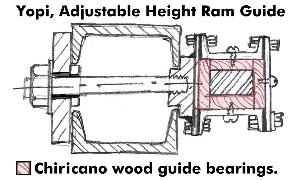
|

|
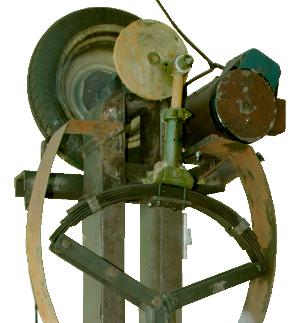
|
|
The bow spring toggle linkage on this hammer works "OK" but is not as efficient as it should be due to a design error.
The spring does not have enough curve and the toggles can never achieve a straight line.
See drawing below for correct spring and toggles.
Height and stroke adjustment: There is a slot milled in the drive wheel for stroke adjustment and a hollow slip coupling on the vertical link for height adjustment. Stroke adjustment can be achieved more simply with a series of drilled holes. Note that this does not work if the crank wheel has a counterweight. The Concrete filled anvil and base is unique on this hammer. While the concrete base is something I suggested many years ago for a JYH, the anvil needs to be more solid (steel, cast iron). Concrete is 29% as dense as steel. This makes it a relatively "light weight" fill. Over time concrete also shrinks and will become loose in the anvil frame. How soon is hard to predict. The loosening may also vary according to how the concrete is keyed to the steel or and how many pieces of rebar criss cross the piece. |
|
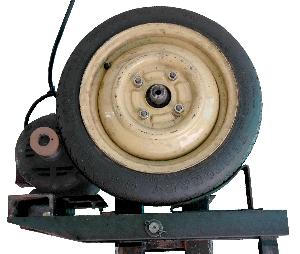
|
Clutch and Brake Combination mounted on the back of the hammer.
This required a shaft and bearing assembly unlike the the NC-JYH tire hammer which uses a single ended hub.
Yopi made his own babbitt bearing with seals for this project.
The extra leverage of the long bracket the motor hangs on made the clutch harder to use than the NC-JYH clutch. However, it worked well enough AND provided a brake which many hammers do not have. |
 Changeable Die Hold Down uses two cams with lever handles and a locking bolt.
A 1" diameter bar pulls down on the die which is keyed into the anvil top.
Changeable Die Hold Down uses two cams with lever handles and a locking bolt.
A 1" diameter bar pulls down on the die which is keyed into the anvil top.
|

|
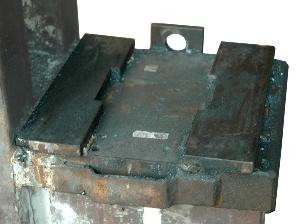
|
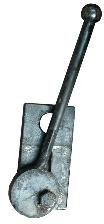 Die Holder and Cam Lock
Die Holder and Cam LockThis is an ingenious mechanism and it works well. The die has stayed in place during months of daily use. The ram and lower die are made of 4140. Due to its complexity I would not recommend this system but it works well and shows that there are still many new ideas to be tried in hammer construction. |
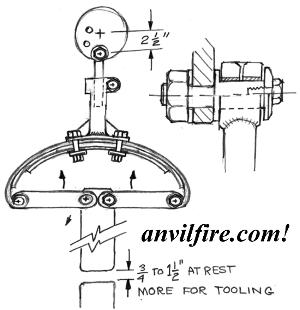
|
The Bow Spring Linkage gives the exact same action as the Dupont linkage of the Little Giant and used on the NC-JYH tire hammer but with less parts.
The leaf spring is both the arms and spring of the Dupont linkage.
The great advantage of the Dupont linkage that is not found in any other type of power hammer linkage is the smooth sinusoidal action and the reversing action that allows the spring to store energy at the top of the stroke and give it back on the way down. To work properly the toggles (side links) must be nearly horizontal or make a straight line at rest. At this point it requires very little motion at low speed for the hammer to strike gently. As the hammer speeds up the stroke increases, energy is stored in the spring and the hammer hits harder. |
|
The Drawing above shows the correct spring and toggle arrangement for this hammer.
The springs must be preloaded sufficiently to support the ram with the toggles nearly horizontal.
Note that due to the infinite leverage at the horizontal position the toggles will always sag 3 to 5 degrees.
The total stroke of a Dupont toggle machine is twice the crank offset, plus the distance between dies and the upward stroke while compressing the spring. In the above that is: |
|
|
Related Links: |
Continued on CR-JYH Page 2 More about Yopi, adjusting the hammer, Josh Greenwood demo. |
| COMMENTS: I would like to go back once a year and check on how well the concrete anvil is holding up. While I do not recommend it for those that can afford the steel for an anvil, it could be an option for those that are impoverished or live in places where steel is very expensive or hard to get. However, it should always be considered a "make-do" or temporary solution. - guru | |
|
|
|